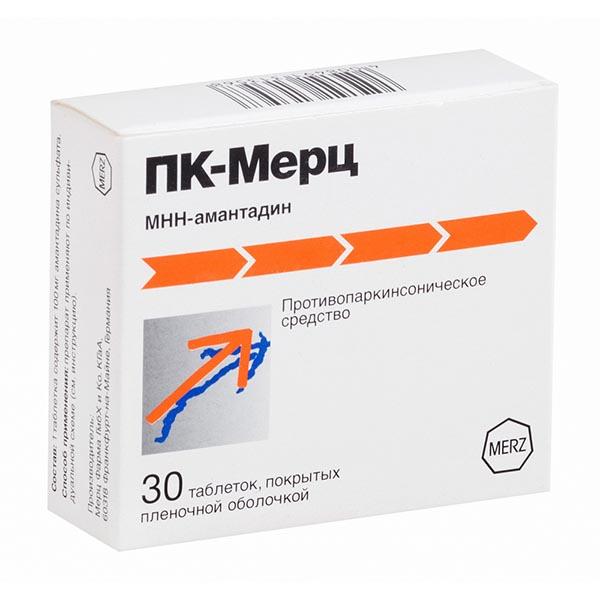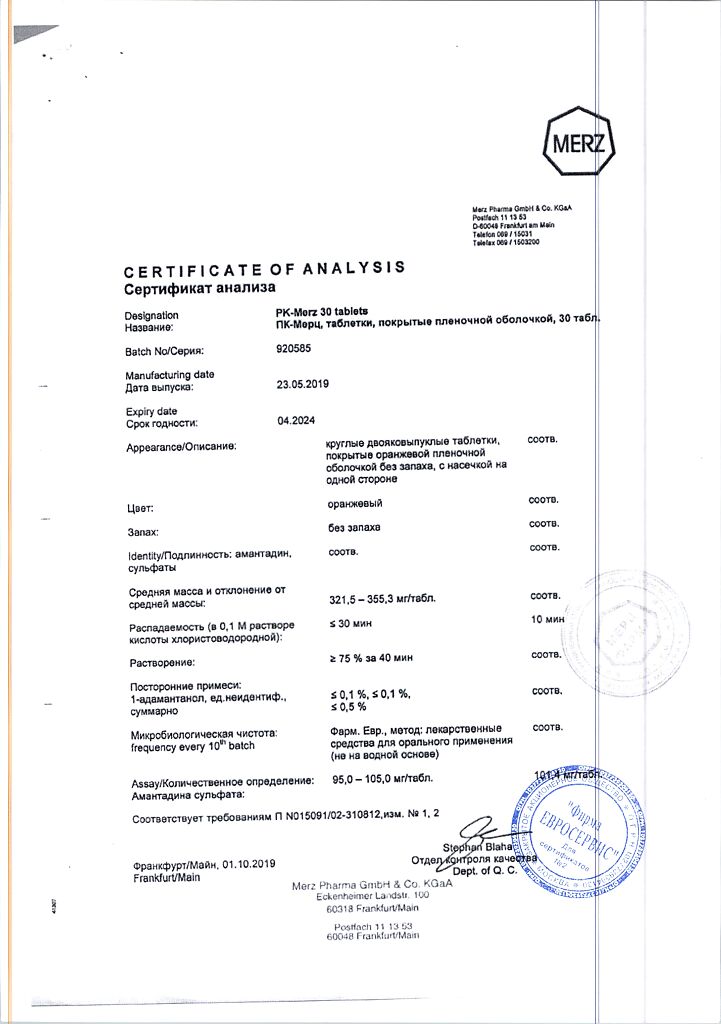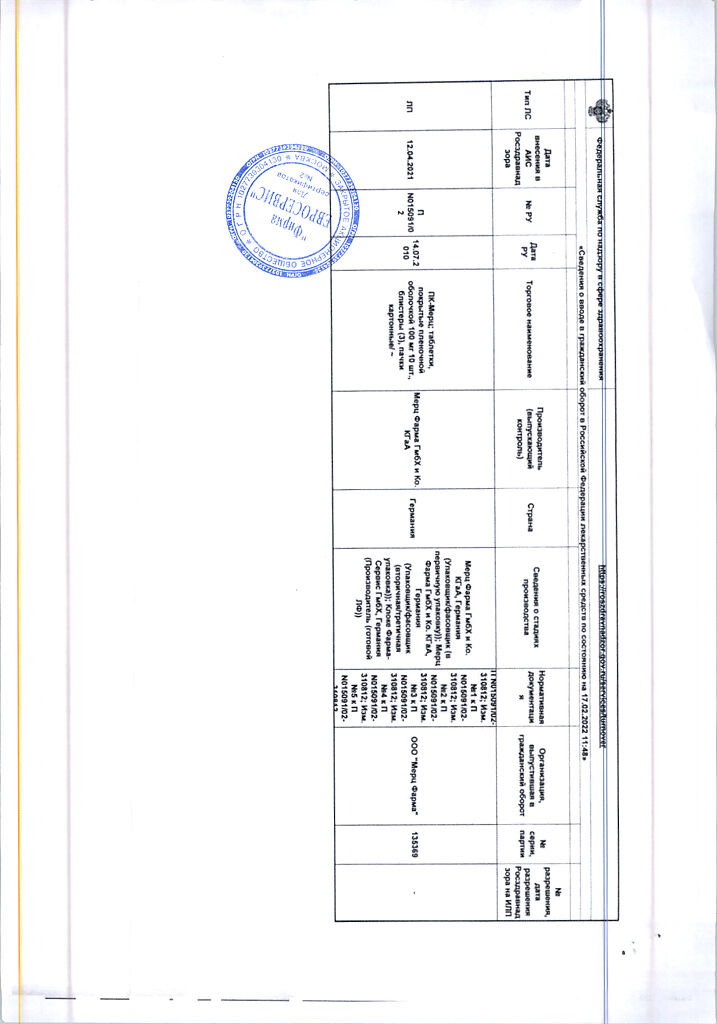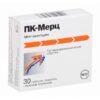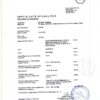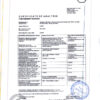No products in the cart.
PC-Merz, 100 mg 30 pcs.
€6.66 €5.83
Description
PK-Mertz is a blocker of glutamate N-methyl-D-aspartate receptors (NMDA-receptors). Antiparkinsonian drug. Amantadine has an indirect agonist effect on striatal dopamine receptors. Increases extracellular concentration of dopamine by both intensification of its production and blockade of dopamine reuptake by presynaptic neurons. In therapeutic concentrations amantadine slows down production of acetylcholine and thus has anticholinergic effect.
Pharmacokinetics
Intake
After a single dose, Cmax is reached within approximately 2-8 hours. After administration of amantadine sulfate at a dose of 100 mg, Cmax is 0.15 µg/mL.
The mean plasma concentration of amantadine sulfate after an IV infusion of 200 mg for 3 hours is 0.54 µL. At a dose of 200 mg/day the mean plasma concentration by the end of day 6 of treatment is 0.76 µL.
Distribution
The binding to plasma proteins is 67%. It penetrates through the BBB.
T1/2 is 10-30 h, on average 10 h. It is excreted practically unchanged by the kidneys (90% of the single dose); a small amount is excreted in the feces. Dialysis is ineffective (about 5% in one session).
The total clearance when administered by IV is 3.6 l/h.
Indications
Indications
Parkinson’s disease (muscle rigidity, tremor, hypo- or akinesia);
extrapyramidal disorders caused by taking antipsychotics or other drugs;
neuralgia with herpes zoster.
Pharmacological effect
Pharmacological effect
PC-Merz is a blocker of glutamate N-methyl-D-aspartate receptors (NMDA receptors). Antiparkinsonian drug. Amantadine has an indirect agonistic effect on striatal dopamine receptors. Increases the extracellular concentration of dopamine by both intensifying its production and blocking the reuptake of dopamine by presynaptic neurons. At therapeutic concentrations, amantadine slows down the production of acetylcholine and thereby has an anticholinergic effect.
Pharmacokinetics
Suction
After taking a single dose, Cmax is achieved within approximately 2-8 hours. After taking amantadine sulfate at a dose of 100 mg, Cmax is 0.15 mcg/ml.
The average plasma concentration of amantadine sulfate after intravenous infusion at a dose of 200 mg over 3 hours is 0.54 μl. At a dose of 200 mg/day, the average plasma concentration by the end of the 6th day of treatment is 0.76 μl.
Distribution
Plasma protein binding is 67%. Penetrates through the BBB.
Removal
T1/2 – 10-30 hours, on average 10 hours. Excreted by the kidneys almost unchanged (90% of a single dose); a small amount – with feces. Dialysis is ineffective (about 5% per procedure).
The total clearance with intravenous administration is 3.6 l/h.
Special instructions
Special instructions
Treatment with PK-Merz should not be stopped suddenly, as this may lead to a worsening of symptoms.
Patients suffering from cardiovascular diseases should be under constant medical supervision when prescribing the drug PK-Merz.
Alcohol intake is contraindicated during treatment.
Influence on the ability to drive vehicles and operate machinery. Use with caution while working for vehicle drivers and people whose profession involves increased concentration of attention.
Active ingredient
Active ingredient
Amantadine
Composition
Composition
Active ingredient:
Amantadine sulfate 100 mg
Excipients:
Microcrystalline cellulose,
potato starch,
gelatin,
lactose monohydrate,
povidone,
talc,
magnesium stearate,
colloidal silicon dioxide,
croscarmellose sodium,
titanium dioxide,
butyl methacrylate copolymer,
dye orange yellow
Contraindications
Contraindications
severe congestive heart failure (functional class IV according to the NYHA classification);
cardiomyopathy;
myocarditis;
AV block II and III degrees;
bradycardia (heart rate less than 55 beats/min);
prolongation of the QT interval more than 420 ms;
ventricular arrhythmia (including ventricular flutter);
hypokalemia;
hypomagnesemia;
simultaneous use with drugs that prolong the QT interval;
severe renal failure (creatinine clearance <10 ml/min);
childhood;
only for tablets - hereditary galactase deficiency, lactase deficiency, glucose/galactose malabsorption syndrome, sucrase/isomaltase deficiency, hereditary fructose intolerance;
phenylketonuria;
pregnancy;
breastfeeding period;
hypersensitivity to any of the components of the drug.
The drug should be prescribed with caution in cases of prostatic hyperplasia, angle-closure glaucoma, renal failure of varying severity (there is a risk of drug accumulation), agitation, delirium, central nervous system depression, exogenous psychosis (including a history), when taken together with memantine, triamterene/hydrochlorothiazide.
Side Effects
Side Effects
Mental disorders accompanied by visual hallucinations.
Rarely – motor and mental agitation.
Urinary retention in patients with prostate adenoma.
Heart failure.
Arrhythmia, tachycardia, nausea, dry mouth, dizziness, sleep disorder.
Very rarely – the appearance of a bluish coloration of the skin of the upper and lower extremities, decreased visual acuity.
Interaction
Interaction
Concomitant use of diuretics, which are a combination of triamterene/hydrochlorotidezide, may lead to changes in the plasma concentration of amantadine.
When combined therapy with other anti-parkinsonism drugs, it may be necessary to adjust the doses of other drugs or the combination as a whole accordingly, otherwise side effects may increase.
Overdose
Overdose
Symptoms: nausea, vomiting, tremor, ataxia, decreased visual acuity, lethargy, dysarthria, epileptic seizures, arrhythmia.
Treatment: gastric lavage, taking activated carbon, symptomatic therapy.
Storage conditions
Storage conditions
Store at a temperature not exceeding 25°C.
Shelf life
Shelf life
5 years.
Manufacturer
Manufacturer
Kloke Pharma-Service GmbH, Germany
Additional information
| Shelf life | 5 years. |
|---|---|
| Conditions of storage | Store at a temperature not exceeding 25 ° C. |
| Manufacturer | Kloke Pharma-Service GmbH, Germany |
| Medication form | pills |
| Brand | Kloke Pharma-Service GmbH |
Other forms…
Related products
Buy PC-Merz, 100 mg 30 pcs. with delivery to USA, UK, Europe and over 120 other countries.

